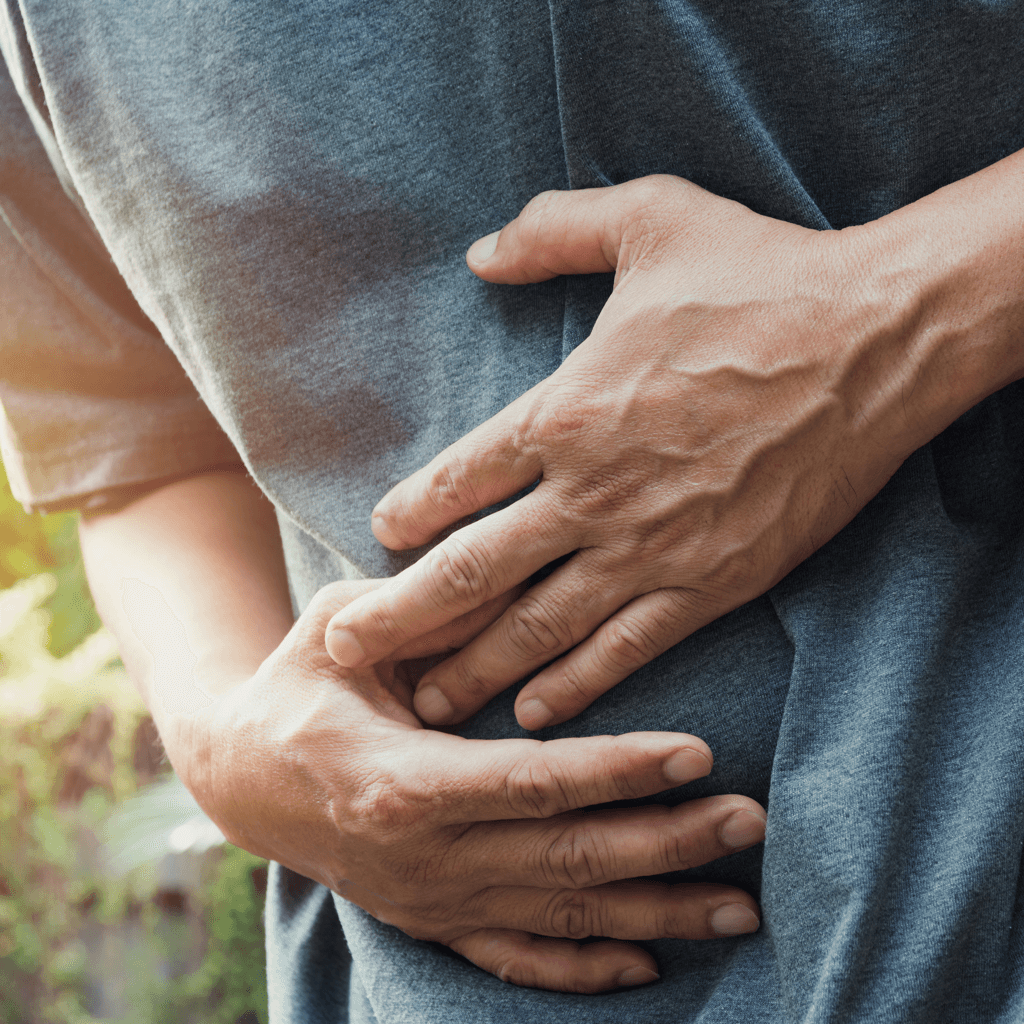Cirrhosis can lead to a number of complications. One of them is an excess of fluid in the abdomen. This is called ‘ascites’ (pronounced ‘a-sigh-tees’). Read on here to learn about how ascites develops, and what treatments are available to manage the symptoms.1
What is ascites and how does it develop?
In ascites, fluid collects in the abdominal cavity. This is caused, among other things, by something called ‘portal hypertension’. Portal hypertension is when the pressure increases inside the portal vein (a large vein inside the liver). Normally, the portal vein should carry blood easily from the abdominal organs to the liver. In cirrhosis, the blood does not flow through the portal vein as easily as it should, due to scarring in the liver. This causes the volume of blood to increase in the veins outside the liver.2
In addition, a cirrhotic liver produces less albumin than it should. Albumin is a protein made by the liver which helps keep fluid in the blood vessels. Due to low levels of albumin in the blood, fluid can leak out from the blood vessels and build up in the abdomen or in the legs. This buildup of fluid is called ‘edema’.3
What are the symptoms of ascites?
Ascites may not be noticeable in the early stages. It can be helpful to monitor your body weight and pay attention to changes in your body.1
- Does your abdomen feel swollen or does it bulge outwards?
- Do you feel an uncomfortable sensation of pressure or fullness?
- Do you feel that you need to work harder to breathe when you are lying down or climbing a flight of stairs?1
If your answer is yes to any of these questions, you should see your doctor. They can examine you and identify the cause of the symptoms. If the doctor finds that you have ascites, they can help you take measures to prevent it from getting worse.1
If you have been diagnosed with ascites, you should take special care of yourself. If at any time, you develop additional symptoms such as abdominal pain or fever, you should see a doctor as soon as possible. These could be signs of a serious condition called ‘bacterial peritonitis’. Bacterial peritonitis is an inflammation of the fluid in the abdomen and of the inner lining of the abdomen.4 In ascites, bacteria from your bowels may get into the tissue that lines the abdominal cavity and surrounds the organs.5 This can make you seriously unwell if it is not treated urgently.6
How can ascites be treated?
Various measures can be taken to help reduce the amount of fluid in the abdominal cavity. This can alleviate symptoms and help to improve quality of life.7
Low-sodium diet
The sodium contained in table salt and other foods can promote water retention. If you are diagnosed with ascites, doctors will therefore advise you to limit your salt intake. Healthy eating tips include cooking your own food and avoiding pre-prepared meals or processed foods, as these often have a high salt content. You can ask your doctor for advice on how to manage your diet.7
Water pills
Diuretics (sometimes known as “water pills”) are medications that increase the passing of water and sodium from the body via the kidneys. Your doctor will decide on the right medication for you.1
Drainage of the ascites (paracentesis)
The doctor may insert a needle into the abdomen to drain the fluid. This procedure is known as “paracentesis”.1 To avoid injury to surrounding organs, and to find a suitable place to insert the needle, an ultrasound machine is often used.7 Not every person with ascites will need to have paracentesis. In some cases, however, it may be necessary to alleviate symptoms. Paracentesis may also be necessary to take a sample of the abdominal fluid, to identify signs of infection or other diseases.7 To prevent the person from feeling pain, a local anesthetic injection is often given around the puncture site.8

If you have been diagnosed with ascites, you should take special care of yourself.
Additional Information
References:
- Nazario, B. WebMD. Ascites. Available at: https://www.webmd.com/digestive-disorders/ascites-medref. Last accessed: October 2020
- Tholey, D. MSD Manual. Portal Hypertension. Available at: https://www.msdmanuals.com/home/liver-and-gallbladder-disorders/manifestations-of-liver-disease/portal-hypertension#. Last accessed: October 2020
- Gounden, V; Vashisht, R; Jialal, I. Stat Pearls, Hypoalbuminemia. Available at: https://www.ncbi.nlm.nih.gov/books/NBK526080/. Last accessed: October 2020
- Chinnock, B. BMJ Best Practice. Spontaneous Bacterial Peritonitis. Available at: https://bestpractice.bmj.com/topics/en-gb/793#. Last accessed: October 2020.
- Shlamovitz, G. Medscape. Paracentesis. Available at: https://emedicine.medscape.com/article/80944-overview. Last accessed: October 2020
- Tholey, D. MSD Manual. Spontaneous Bacterial Peritonitis. Available at: https://www.msdmanuals.com/en-gb/professional/hepatic-and-biliary-disorders/approach-to-the-patient-with-liver-disease/spontaneous-bacterial-peritonitis-sbp. Last accessed: November 2020
- Cesario, K; Choure, A; Carey, W. Cleveland Clinic. Cirrhotic Ascites. Available at: https://www.clevelandclinicmeded.com/medicalpubs/diseasemanagement/hepatology/complications-of-cirrhosis-ascites/. Last accessed: October 2020
- Intermountain Healthcare Gastroenterology Team. Intermountain Healthcare. Paracentesis. Available at: https://intermountainhealthcare.org/services/gastroenterology/treatment-and-detection-methods/paracentesis/. Last accessed: November 2020
May 2021. GL-HEP-XIF-2000181




